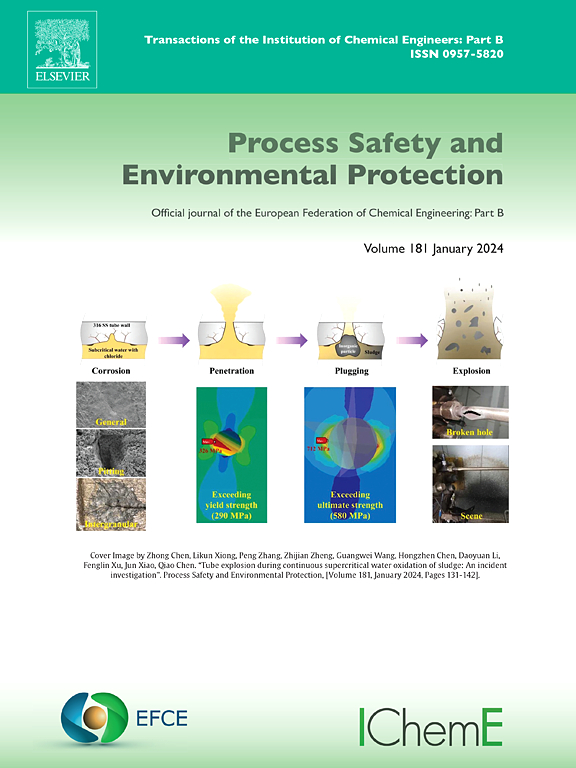基于贝叶斯概率和关联规则的石化设备腐蚀机理识别混合诊断系统
IF 6.9
2区 环境科学与生态学
Q1 ENGINEERING, CHEMICAL
引用次数: 0
摘要
本研究提出了一种基于关联规则挖掘和贝叶斯分类的石化和化工行业固定设备腐蚀退化机制诊断模型。该模型解决了与传统腐蚀诊断相关的挑战,包括专业知识不足、缺乏专家和复杂的评估过程。通过整合国际标准和采用数据驱动的方法,该模型提供了腐蚀降解机制的定量诊断结果。该模型将腐蚀机制的理论基础与实际操作数据相结合,能够诊断91种降解机制,包括11种材料类型、广泛的工作温度范围、15种化学品和各种加载条件。为了验证模型的准确性,以雪佛龙事故为例进行了模拟。结果表明模型的输出结果与事故调查报告的结果一致,从而证实了模型的有效性。本研究开发的诊断工具提高了腐蚀退化评估的准确性和效率,并随着更多案例数据的积累,提供了动态改进的潜力。通过提供各种退化机制概率的定量指标,该模型有助于早期发现设备异常,并为后续分析(如基于风险的检查(RBI)、服务适应性(FFS)和完整性操作窗口(IOW))提供坚实的基础。本文章由计算机程序翻译,如有差异,请以英文原文为准。
A Hybrid Diagnostic System for Corrosion Mechanism Identification in Petrochemical Equipment: Integrating Bayesian Probabilities and Association Rule
This study proposes a diagnostic model for corrosion degradation mechanisms in fixed equipment within the petrochemical and chemical industries, based on association rule mining and Bayesian classification. The model addresses challenges associated with traditional corrosion diagnosis, including insufficient expertise, lack of specialists, and complex evaluation processes. By integrating international standards and employing a data-driven approach, the model provides quantitative diagnostic results for corrosion degradation mechanisms. Combining the theoretical foundation of corrosion mechanisms with real-world operational data, the model is capable of diagnosing 91 types of degradation mechanisms, encompassing 11 material types, a wide operating temperature range, 15 chemicals, and various loading conditions. To validate the model's accuracy, a simulation was conducted using the Chevron accident case. The results demonstrated consistency between the model's outputs and the findings of the accident investigation report, thereby confirming its effectiveness. The diagnostic tool developed in this study enhances the accuracy and efficiency of corrosion degradation assessments and offers the potential for dynamic improvement as more case data is accumulated. By presenting quantitative indicators of the probabilities of various degradation mechanisms, the model facilitates the early detection of equipment abnormalities and provides a solid foundation for subsequent analyses such as Risk-Based Inspection (RBI), Fitness for Service (FFS), and Integrity Operating Windows (IOW).
求助全文
通过发布文献求助,成功后即可免费获取论文全文。
去求助
来源期刊

Process Safety and Environmental Protection
环境科学-工程:化工
CiteScore
11.40
自引率
15.40%
发文量
929
审稿时长
8.0 months
期刊介绍:
The Process Safety and Environmental Protection (PSEP) journal is a leading international publication that focuses on the publication of high-quality, original research papers in the field of engineering, specifically those related to the safety of industrial processes and environmental protection. The journal encourages submissions that present new developments in safety and environmental aspects, particularly those that show how research findings can be applied in process engineering design and practice.
PSEP is particularly interested in research that brings fresh perspectives to established engineering principles, identifies unsolved problems, or suggests directions for future research. The journal also values contributions that push the boundaries of traditional engineering and welcomes multidisciplinary papers.
PSEP's articles are abstracted and indexed by a range of databases and services, which helps to ensure that the journal's research is accessible and recognized in the academic and professional communities. These databases include ANTE, Chemical Abstracts, Chemical Hazards in Industry, Current Contents, Elsevier Engineering Information database, Pascal Francis, Web of Science, Scopus, Engineering Information Database EnCompass LIT (Elsevier), and INSPEC. This wide coverage facilitates the dissemination of the journal's content to a global audience interested in process safety and environmental engineering.
 求助内容:
求助内容: 应助结果提醒方式:
应助结果提醒方式:


